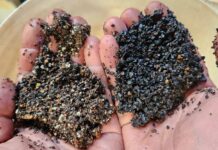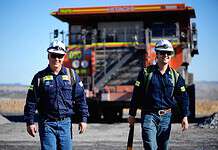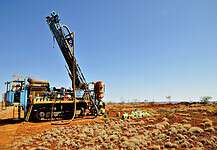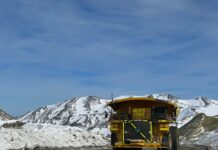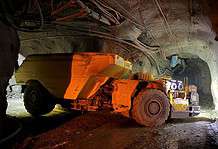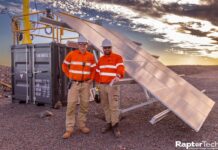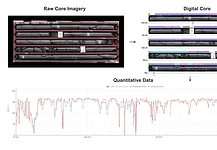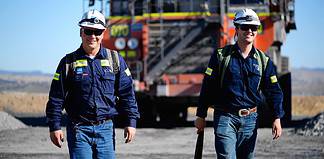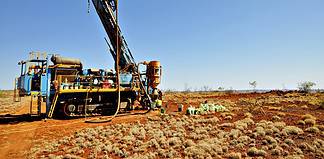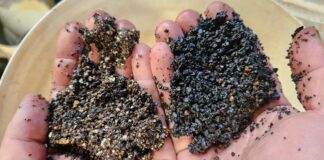Rio Tinto’s Silvergrass iron ore operation. Image: Rio Tinto.
BY CAMERON DRUMMOND
IT’S been tough – but things are looking up for the Pilbara mining region, as iron ore continues to rip higher on steady Chinese demand and exciting opportunities in lithium and gold come into play.
Known as the engine room of Australia, the WA Pilbara is the largest iron ore producing region in the world, accounting for almost 37 per cent of global production and 52 per cent of seaborne exports in 2015.
Iron ore mining in the Pilbara commenced in the 1960s, after the Australian Government lifted an embargo on iron ore exports in 1938 in the lead up to World War II.
By the 1970s, pioneering companies such a BHP, and Rio Tinto-owned Hamersley Iron and Robe River Iron, had established the towns of Tom Price, Newman, Paraburdoo, Karratha and Dampier;
including investment in community infrastructure, power and water supply, roads and suburban street lighting.
BHP and Rio constructed hundreds of kilometres of railway – forming two of the biggest privately-owned rail networks in the world – to link the Pilbara’s iron ore to the coast for export.
Rising output
In response to Chinese growth in steel production over the last 15 years, billions of dollars have been invested in the region, growing iron ore production three-fold at an average rate of 12 per cent per annum, from 243 million tonnes per annum (mtpa) in 2004-05 to 757mt in 2015-16.
China’s increase in demand over the years resulted in the iron ore price rising from about $US30/tonne (t) in 2003-04, to more than $US150/t by 2012.
However, by the start of 2014 increased iron ore production started to displace higher cost production in China.
This, combined with lower demand from Chinese steelmakers, caused the iron ore price to fall by 42 per cent in 2014-15, and a further 28 per cent in 2015-16.
The commodity bottomed out at a low of $US37/t in December 2015, and the effects rippled through the Pilbara as projects stalled and miners tightened their belts, resulting in job losses and a concern for the future of WA’s north west.
Iron ore bounced back during 2016, and by February this year reached a high of
$US89/t.
During FY17, WA produced a record 790mt of iron ore, an increase of 6 per cent year-on-year; 92 per cent of which was produced in the Pilbara.
These higher sales volumes and stronger prices delivered a 31 per cent increase in sales value from $48.8 billion in FY16 to $63.7bn in FY17.
The WA Treasury’s Financial Projections Statement forecasts iron ore sales to increase to 830mt by 2019-20.
While sales of iron ore from WA are expected to continue to rise as mine construction and expansions are completed, it is expected that the rate of increase will be slower than the past 10 years.

Lifting Australia’s prosperity
WA Mines and Petroleum minister Bill Johnston said that sustaining a globally competitive Pilbara resources sector was an important part of the economic benefits to WA and the nation.
“A healthy mining industry in the Pilbara is essential to the WA economy, it underpins all other activity in the State and indeed carries the nation’s exports and allows us to have a very high standard of living in Australia,” Mr Johnston said.
Mr Johnston also believed the Pilbara did not receive the national attention it deserves to ensure industry in the region remained prosperous.
“There’s no question that politicians on the east coast and in Canberra overlook the Pilbara constantly and don’t properly appreciate how important the region is,” he said.
“You often hear debate about Sydney Airport and how important it is for the national economy – however Port Hedland is actually more important yet gets virtually no discussion.
“There’s never any debate on how the Commonwealth Government can assist in maintaining and expanding the infrastructure for the iron ore sector.
“Our national wealth would be much lower without it and we wouldn’t be able to import all the luxuries that we enjoy today.”
Pilbara Development Commission chief executive Terry Hill said that the Pilbara should not rely solely on iron ore and attempt to future proof the region against another downturn.
“The Pilbara will undoubtedly continue to be the nation’s economic powerhouse, however there is no denying the Pilbara is in a transition, and the region is increasingly confronted by changing global
mega trends,” Mr Hill said.
“The role of the commission will be to ensure the Pilbara captures and actively pursues transformational market opportunities.”
Mr Johnston said the WA Government was aware of the importance of injecting revenue back into the communities in which industry operates.
“One of the things the Labor Government has done recently is encourage mining companies to hire
more local apprentices and review their contracting arrangements to ensure that local businesses in the Pilbara can benefit from the opportunities provided by the massive mining sector,” Mr Johnston said.
“We are also investing in important road infrastructure and putting regional services on a sustainable basis, such as the Patient Assisted Travel Scheme (PATS) scheme to make sure health services are
available to regional people.
“We are also looking at each of the Indigenous communities and see what the government can do to make those communities more sustainable.
“We want to make sure that the money we spend in Royalties for Regions is done on a value for money basis.”

Iron ore development
Today, the Pilbara’s three major iron ore producers, BHP, Rio Tinto and Fortescue Metals Group are responsible for the lion share of production and development in the region.
All have recently pledged massive capital outlays to maintain output as older operations reach the end of their production lives.
Rio Tinto recently celebrated the opening of its $US338 million Silvergrass mine, adding an extra 10mtpa of high-quality ore to raise total production up to 340mtpa creating 500 jobs during construction.
“The additional low-phosphorus tonnes that Silvergrass delivers will sustain the long-term viability of our Pilbara blend, ensuring continued premium pricing, whilst also lowering our operating costs through infrastructure improvements,” Rio Tinto chief executive Jean-Sebastien Jacques said.
BHP is creating hundreds of job opportunities after ‘The Big Aussie’ approved $244m of initial funding to develop its $US3.2 billion South Flank project in June.
The move would help the miner maintain its WA iron ore production when its Yandi mine reaches the end of its mine life in the early-to-mid 2020s.
BHP said the Mining Area C hub was its preferred option to replace production from the 80mtpa Yandi operation.
FMG too expects it will spend about $US1.5 billion to replace exhausted production from its Firetail mine.
Gold rush
Excitement is brewing in the Pilbara, albeit from an unlikely source – gold.
The news kicked off this year when Canada-based Novo Resources and JV partner Artemis Resources discovered surface-rock gold at its Purdy’s Reward prospect south of Karratha.
Both went to market for funding to begin exploration work, with Artemis quickly raising $12m to advance the project. Kairos Minerals – previously lithium focused – jumped on the news, confirming
to the market field assay results similar to Purdy’s Reward at its own nearby tenements.
De Grey Mining also dusted off its Pilbara Gold project tenements, uncovering 91 shallow lying nuggets.
Significantly, they were of a smooth yet pitted appearance comparable to the Witwatersrand mineralisation style – a geological formation near Johannesburg, South Africa, that now holds the world’s biggest gold reserves.
The discovery attracted growing mid-tier Canadian gold producer Kirkland Lake Gold, which invested $5m into the junior to further exploration activities.
All three ASX-listed companies finished September with more than triple their value before the finds.
In a note entitled Watermelon Nugget Patch, Argonaut analysts raised caution that “nuggety” gold occurrences were commonly isolated and uneconomic for large-scale exploitation.
“Speculative activity and nearology will continue to drive volatility and high trading volumes until drilling and sampling prove or disprove an economic discovery,” they said.
Other exploration juniors that have revealed prospective results in the region include Calidus Resources, Kalamazoo Resources and Castle Minerals.
Lithium
However, it is not only gold that has got the Pilbara region buzzing.
Near-production lithium developers Altura Mining and Pilbara Minerals, with their neighbouring Pilgangoora projects, are transforming the Pilbara into one of the world’s global lithium hotspots.
Pilbara Minerals is on track for Stage 1 production of 314,000 tonnes of 6 per cent lithium spodumene concentrate in Q2 2018.
Similarly, Altura expects to output 230,000t starting in Q1 2018.
Rather than in direct competition, the companies seem to be working together to help their projects come to fruition.
In August last year, Altura and Pilbara Minerals struck a joint access agreement to remove any objections from either company’s tenure and share joint access roads and pipeline locations.
The MoU also provides frameworks to exploit lithium-rich zones that cross through each other’s tenements.
“We are pleased to have entered into these arrangements with Altura, which demonstrates a positive and collaborative approach to the development of valuable resources in this State which will ultimately benefit a wide range of stakeholders.” Pilbara Minerals managing director Ken Brinsden said.
Both miners are working on Stage 2 expansions, which would bring their combined output from the region to more than 1.25mtpa.



